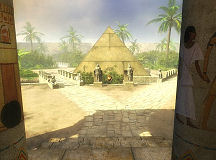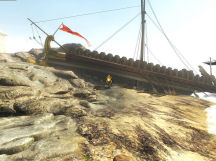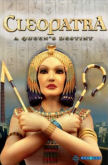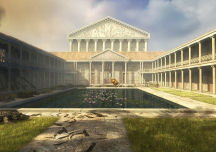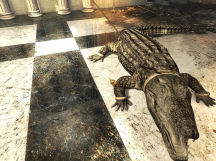“Welcome to Alexandria. My palace is at your
disposal.” With this gracious invitation,
Cleopatra invites you into Kheops Studio’s latest offering.
Story
Strangely enough, Cleopatra: A Queen’s Destiny (Cleopatra: AQD)
is not a game about Egypt’s most famous queen. Instead, it focuses on
Thomas, a young Chaldean in Alexandria studying with the foremost
astrologer of the time, Akkad. Sadly, a violent civil war between
Cleopatra and her brother-spouse Ptolemy for control of Egypt has broken
out.
Though strife and destruction rule most of Alexandria, the astronomical
observatory and its environs are a haven of peace. That is, until the
morning Thomas finds blood on the walkway and no sign of his beloved Iris
or her father (his teacher), Akkad.
What has happened? Whose blood was spilled? Where are Iris and Akkad?
Are they safe? Do they need help? Are they even alive? Thomas has no
answers and desperately wants some. Thus begins his (and your) journey
towards destiny.
Graphics
The opening screen of Cleopatra: AQD is the most striking of any
game I’ve seen. Kheops cleverly integrates the main menu choices into
Cleopatra’s palatial surroundings. This is where you begin the game,
adjust options, and where you’ll return to save or quit the game.
Though it does not have state-of-the-art graphics, Cleopatra: AQD
is a visually pleasing game. Its vivid colors and engaging areas invite
you in to investigate. Like many people, I am captivated by the Egypt of
the Pharaohs. So it was with great satisfaction that I explored the
various locations, including a quick trip to the Great Library of
Alexandria. The Library was no longer in pristine condition, but it was
still gratifying to visit this ancient center of learning.
You’ll begin the game in the Observatory Garden, whose sunlit walkways
beckon you on to new discoveries. Abundant, verdant plants, ornate
statues, shimmering fountains and a small pond surround a mysterious
central pyramid. A damaged wall disturbs this tranquil setting and
reflects the sad reality of war. Though the water ripples and moves, all
else is strangely still.
My favorite location was the Isle of Pharos. I savored all the movement
found there as much as I missed it in other locations. The sea pounds the
shore and gulls soar, calling to each other, and pennons flutter in the
wind.
Characters
This is not a solitary experience. Thomas interacts with several
“charming” characters. To name a few, there is Cleopatra herself, regal
and imperiously demanding. You’ll meet Kordax, a hunchbacked slave
possessing a strange demeanor, and you’ll be challenged by a fanatical
priest. Certainly the most unusual non-player character by far is an old
crocodile named Souchous.
The cast is clad exactly as one expects in an Egyptian setting. Thomas
sports a toga and sandals and Cleopatra’s clothing is alluring. The
priest, with his shaven head and short kilt, could have come from any of
the numerous movies set in this time period.
Though the costumes are spot on, movements, unfortunately, seem a bit
stiff, skin a tad too smooth and shiny for reality. Mouth movements are
well synchronized to speech, but somehow, there is no life in the faces.
I respected Thomas' dedication to Iris and Iris’
determination to complete her task, and I eventually grew fond of them.
However, I initially had a tough time connecting with them as characters.
Perhaps part of the problem can be attributed to the dialogue and the
voice acting, but I think another part was due to the writers’ choice of
names. For a game set in the last Egyptian pharaoh’s court, “Thomas” and
“Iris” struck me as incongruous. Though I am aware that people from many
countries served the pharaohs, it was a little disconcerting at first.
Dialogue
The dialogue in this game is not excessive. Most conversations provide
information needed to progress in the game--and I was delighted to
discover that sometimes when I was stuck, it gave me a little push in the
right direction. It is delivered via the standard dialogue tree and you
always have the choice to “quit dialogue.”
A time or two or maybe even three, words fell strangely on my ear,
striking me as anachronistic. Also, I noticed an awkward
translation--“localize” being substituted for “locate.” Finally, the
narration in one scene is in the wrong tense.
Voice Acting
The voice acting is a mixed bag. Most of the voices are pleasant, and
none are irritating, but several lack inflection and prosody. Cleopatra’s
utterances were often inappropriately rushed.
Thomas’ voice switches frequently—sometimes young but at other times
sounding quite old. This really confused me for a while until I realized
(or did I rationalize) that the older voice was that of the narrator and
must represent a Thomas who is looking back and recounting this tale for
us.
Iris’ voice fits her character the best, in part because she is more
expressive than her counterparts.
Sound
Though not present in every scene, Cleopatra: AQD’s background
music suits the game admirably. Running the gamut from meditative to
tension-inducing, it sets the mood and then steals silently away.
Most of the time, your adventures will be accompanied only by ambient
sounds. Cheerful bird song contrasts nicely with the cacophony of war
outside the garden’s wall. Surf roars, chains clank, and winds howl, all
adding to the immersive quality of the game. The presence of environmental
sounds always helps me to feel as if I’m really in the game, and they did
so nicely in this one.
Puzzles
Some players will consider this an unusually short game. I finished it
in less than fifteen hours. However, the length of a game depends somewhat
on the gamer’s experience, the time he/she is willing to spend before
giving up and asking for help, and the nature of the obstacles.
Cleopatra: AQD provides a mix of inventory, mechanical, and
logic puzzles which flow naturally from the story. There are no mazes, no
timed challenges, and no solely color or sound dependent puzzles. Also,
you won’t find a slider or a mini-game, and, happily, you cannot die. The
game's conundrums run the gamut from easy to medium-hard. I did the “aha
happy dance” several times upon completing the more complicated ones.
I enjoyed the puzzles but did have a small quibble with the way a
couple of them worked. They both required replicating an object several
times. The first time is a challenge, as you work out which ingredients
must be combined. After that, it is just busy work. I would have much
preferred a cut scene showing said articles being made after I
successfully made the first one.
Interface
This first person game is wholly point and click, and is Alt+Tab
friendly. Game play is easy and intuitive thanks to the excellent
interface.
Inventory Page:
Right clicking opens your inventory page, which is so much more than a
place to store “junk.” Of course, it holds the items you collect as you
explore, but it also gives you six tabbed pages allowing you to arrange
your inventory according to your individual preferences. Combining
inventory is sometimes necessary and is easily done by dragging one object
to another.
The inventory page features a very useful journal. As you explore,
Thomas’ thoughts are recorded. Checking this diary serves as a memory
refresher, and may also give a bit of direction.
“Dialogue History” contains all the discourse encountered in your
journey. This handy feature allows you to read conversations you may have
missed due to life’s intervention, and eliminates the need to take notes.
The Map:
The inventory page also includes a map. A quick click on it whisks you
to your chosen location. This is always a big plus in a game, as I don’t
particularly like trudging to and fro. Although helpful and easy to use,
it had an intermittent graphics glitch.
Icons appear on the map as you discover new areas, and hovering the
mouse over them reveals location labels. From time to time, the icons were
missing. However, I could still use the map by moving the mouse slowly
over its face to display the labels. I never discerned a pattern to this
hitch, but as the map is not large, it wasn’t a show-stopper.
Saves:
Saves are at will and unlimited. I am a frequent saver and I
particularly liked the save sequence. First, the scroll on the stand in
the palace is magically inscribed, and then it mysteriously rolls itself
up for storage. You can’t name your saves. Instead, each one has a small
picture and a time stamp.
Odds and Ends
Thanks to the smart cursor and 360 degree panning, you can search large
areas fairly quickly. Just stand still and scan around, watching for the
pointer to change, indicating possible actions.
Cleopatra: AQD allows five separate profiles, so more than one
member of the family can have a game going simultaneously. Alternately,
you can play again using a different profile without losing your saves.
Game play is affected to some extent by the astrological sign you select
at the beginning. This adds replay value since selecting a different sign
yields a slightly different experience.
The PDF manual installs on your hard drive.
If you wish to hear the music again or watch a particular cut scene,
you simply select the appropriate panel from a wall in Cleopatra’s room.
Stability/Glitches
In addition to the aforementioned vanishing icon map problem, a section
of a catapult blinked in and out from certain viewpoints.
As I experienced no crashing or hanging, I am pleased to report the
game was stable.
Availability
As of this writing, Cleopatra: AQD is available only by download
from
Kheops Web Shop. My medium speed DSL crawled along requiring 7 hours,
32 minutes, and 35 seconds to download the game’s 1.7 gigabytes. (It began
at 23 kilobytes per second and ended at 300+) However, reported download times
vary widely, ranging from less than an hour to 12 hours plus.
Summary
Though there are some areas that could have been improved, the bottom
line is that Cleopatra: A Queen’s Destiny is a fun game. The
puzzles are easy enough that I solved most of them on my own, and hard
enough to make me feel good about it. The story’s twists and turns and
curious happenings, along with my interest in Thomas and Iris, kept me
intrigued all the way to the game’s poetic ending. The surroundings
allowed me to feel as if I’d visited some parts of an Egypt of bygone
days. The music set the mood while the game’s sounds increased the feeling
of being there. I wish all games had such an easy-to-use interface.
Kheops Studios has once again produced a game that does what games are
supposed to do—entertain, and they did it well. Isn’t that what gaming is
all about?
Grade: B+
Shortlist
1st person
perspective
Point and click controls
360 degree panning
Save at will
Unlimited saves
Alt+tab friendly
Stable, with 2 very minor
graphics issues
PDF Manual
Voice acting average
Excellent ambient sounds
Background music intermittent,
but appropriate and adds to immersive experience
Colorful, mostly static
graphics
Characters slightly plastic in
look
Dialogue moves game along, but
is not compelling
Well integrated puzzles --
mostly inventory, logic, or mechanical
No timed, no color or sound
dependent puzzles
No mazes
No minigames
No dying
Excellent interface includes
journal, a transcript of all game dialogue, and a map for instantaneous
transport
Game play time between 10 and
15 hours
Astrological sign chosen
influences game experience to some degree
I played on:
Win XP Professional SP1
3.2 GHz Intel Pentium 4
1 GB Dual Channel DDR400 SDRAM
128 DDR NVIDIA Geforce FX5200
Ultra (video card)
